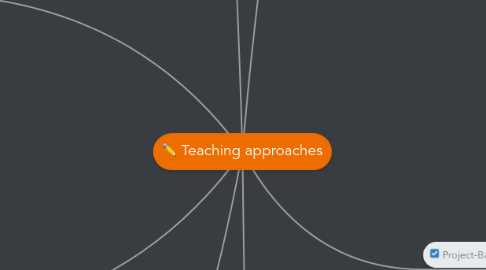
1. Content-Based Instruction
1.1. Integrates learning of specific subject matter with L2 learning
1.1.1. Allows learner to acquire knowledge and skills
1.1.2. Learners are focused on useful practical objectives
1.2. More content than languege
1.2.1. Teaching has to be seen with a different perspective
1.2.2. English for specific purposes
1.3. The language is just the medium
1.4. Allows complete itegration of language skills
2. Theme-Based Instruction
2.1. Work through topics
2.2. Equal value between content and language
2.3. English for academic puorposes
2.4. Principles of TBI
2.4.1. Automaticity
2.4.2. Meaningful learning
2.4.3. Intrinsic motivation
2.4.4. Communicative competence
2.5. Challenging topics engage curiosity and increase motivation
3. Experiential Learning
3.1. Activities that engage
3.1.1. Left and right-brain processing
3.1.2. Contextualize language
3.1.3. Integrate Skills
3.1.4. Point to real-world purposes
3.2. Concrete experiences
3.2.1. "Discover" language
3.3. Give Ss opportnities to use language
3.3.1. Language is the target
3.3.2. Ss grapple with problem-solving complexities
3.4. Tend to be learner-centered by nature
3.5. Can use Ss' personal experiences
3.6. Involves Learners in physical actions
4. The Episode Hypothesis
4.1. Presents language in an easily followed storyline
4.2. It is enhanced if Ss receive interconnected sentences
4.3. The interaction of cognition and language enables Ss to for "expectancies"
5. Task-Based Instruction
5.1. It is organized around communicative tasks
5.2. Task
5.2.1. Meaning id primary
5.2.2. A communication problem to solve
5.2.3. Real-world activities
5.2.4. Task completion has priority
5.2.5. Assessment in terms of outcome
5.3. Target tasks
5.3.1. Ss accomplish beyond the classroom
5.3.2. More specific and related to classroom instruction
5.4. Pedagogical tasks
5.4.1. Nucleus of classroom activity
5.4.2. Involves Ss in a target task simulation
5.5. Dimmensions of communicative tasks:
5.5.1. Goal
5.5.2. Input from the teacher
5.5.3. Role of the teacher and learner
5.5.4. Techniques
5.5.5. Evaluation
5.6. It focuses on a whole set of real-world tasks themselves
6. Project-Based Learning
6.1. Allows Ss to learn by doing and applying ideas
6.2. Ss engage in real world activities
6.3. Situated learning
6.3.1. Ss gain understanding of material when they construct their understanding
6.3.1.1. By working with and using ideas
6.4. Ss engage in real, meaningful problems that are important for them
6.5. Allows Ss to:
6.5.1. Investigate questions
6.5.2. Propose hypothesis and explanations
6.5.3. Discuss their ideas
6.5.4. Challenge other's ideas
6.5.5. Try out new ideas
6.6. Design
6.6.1. Driving question
6.6.1.1. Drives and organizes the project
6.6.2. Situated inquiry
6.6.2.1. Frame hypotheses
6.6.3. Collaborations
6.6.3.1. Ss collaborate with others Ss and Ts in their classrooms
6.6.4. Technological tools to support learning
6.6.4.1. Access real data on the World Wide Web
6.6.5. Creation of artifacts
6.6.5.1. Set of tangible products
7. The Focal skills approach
7.1. Accelerates language acquisition through comprehensible input
7.2. Work with 4 modules
7.2.1. Listening
7.2.2. Reading
7.2.3. Writing
7.2.4. Advanced
7.3. Uses authentic materials
7.4. Integrates skills in a particular way
7.4.1. Employ certain skills as tools to develop others
